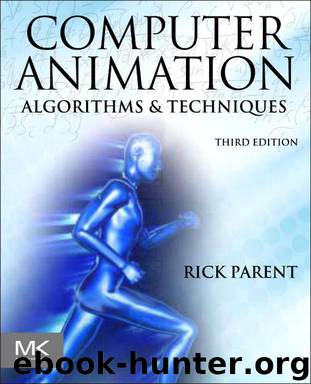Computer Animation: Algorithms and Techniques by Parent Rick

Author:Parent, Rick [Parent, Rick]
Language: eng
Format: mobi
ISBN: 9780124159730
Publisher: Elsevier Science (reference)
Published: 2012-10-09T16:00:00+00:00
(7.91)
7.6 Enforcing soft and hard constraints
One of the main problems with using physically based animation is for the animator to get the object to do what he or she wants while having it react to the forces modeled in the environment. One way to solve this is to place constraints on the object that restrict some subset of the degrees of freedom (DOF) of the object’s motion. The remaining DOF are subject to the physically based animation system. Constraints are simply requirements placed on the object. For animation, constraints can take the form of colocating points, maintaining a minimum distance between objects, or requiring an object to have a certain orientation in space. The problem for the animation system is in enforcing the constraints while the object’s motion is controlled by some other method.
If the constraints are to be strictly enforced, then they are referred to as hard constraints. If the constraints are relations the system should only attempt to satisfy, then they are referred to as soft constraints. Satisfying hard constraints requires more sophisticated numerical approaches than satisfying soft constraints. To satisfy hard constraints, computations are made that search for a motion that reacts to forces in the system while satisfying all of the constraints. As more constraints are added to the system, this becomes an increasingly difficult problem. Soft constraints are typically incorporated into a system as additional forces that influence the final motion. One way to model flexible objects is to create soft distance constraints between the vertices of an object. These constraints, modeled by a mesh of interconnected springs and dampers, react to other forces in the system such as gravity and collisions to create a dynamic structure. Soft constraint satisfaction can also be phrased as an energy minimization problem in which deviation from the constraints increases the system’s energy. Forces are introduced into the system that decrease the system’s energy. These approaches are discussed in the following section.
7.6.1 Energy minimization
The concept of a system’s energy can be used in a variety of ways to control the motion of objects. Used in this sense, energy is not defined solely as physically realizable, but it is free to be defined in whatever form serves the animator. Energy functions can be used to pin objects together, to restore the shape of objects, or to minimize the curvature in a spline as it interpolates points in space.
As presented by Witkin, Fleischer, and Barr [26], energy constraints induce restoring forces based on arbitrary functions of a model’s parameters. The current state of a model can be expressed as a set of parameter values. These are external parameters such as position and orientation as well as internal parameters such as joint angles, the radius of a cylinder, or the threshold of an implicit function. They are any value of the object model subject to change. The set of state parameters will be referred to as ψ.
A constraint is phrased in terms of a non-negative smooth function, E(ψ), of these parameters, and a local minimum of the constraint function is searched for in the space of all parametric values.
Download
This site does not store any files on its server. We only index and link to content provided by other sites. Please contact the content providers to delete copyright contents if any and email us, we'll remove relevant links or contents immediately.
Sass and Compass in Action by Wynn Netherland Nathan Weizenbaum Chris Eppstein Brandon Mathis(13293)
Autodesk Civil 3D 2024 from Start to Finish by Stephen Walz Tony Sabat(7411)
Mathematics for Game Programming and Computer Graphics by Penny de Byl(7310)
Taking Blender to the Next Level by Ruan Lotter(7126)
Express Your Creativity with Adobe Express by Rosie Sue(6916)
Hands-On Unity 2022 Game Development - Third Edition by Nicolas Alejandro Borromeo(6572)
Hands-On Unity 2022 Game Development by Nicolas Alejandro Borromeo(5232)
Unreal Engine 5 Character Creation, Animation, and Cinematics by Henk Venter & Wilhelm Ogterop(4125)
Going the Distance with Babylon.js by Josh Elster(4090)
Squeaky Clean Topology in Blender by Michael Steppig(4006)
Mastering Graphics Programming with Vulkan by Marco Castorina & Gabriel Sassone(3977)
Adobe Illustrator for Creative Professionals by Clint Balsar(3778)
Drawing Shortcuts: Developing Quick Drawing Skills Using Today's Technology by Leggitt Jim(3040)
Unreal Engine 5 Character Creation, Animation, and Cinematics by Henk Venter Wilhelm Ogterop(2944)
Rapid Viz: A New Method for the Rapid Visualization of Ideas by Kurt Hanks & Larry Belliston(2875)
The 46 Rules of Genius: An Innovator's Guide to Creativity (Voices That Matter) by Marty Neumeier(2820)
Learn Qt 5: Build modern, responsive cross-platform desktop applications with Qt, C++, and QML by Nicholas Sherriff(2494)
Fusion 360 for Makers by Lydia Sloan Cline(2337)
Realistic Asset Creation with Adobe Substance 3D by Zeeshan Jawed Shah(2255)
